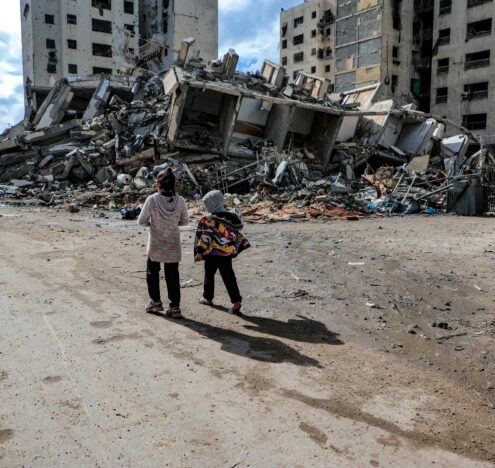At least four times as many veterans and service members of the post-9/11 era have died by suicide than the now 7,060 who died in the Global War on Terror military operations. That is a sobering fact and one that haunts me as a civilian. It is all a bit like our collective house is on fire. We rightly keep running outside to notice the lightning strikes hitting the house when tragedy befalls our combat troops, but we seem woefully unaware that the house was already on fire from within. Our troops and our veterans, even those in support roles who never see combat, are dying by suicide at rates that ought to make us ring the alarms. We need to put the fire out.
I spoke with 53 post-9/11 veterans, service members, and military chaplains from all four branches and various ranks and roles, from cooks to colonels. My field is Sociology of Religion, so my research was on the role of faith in their lives. I was investigating how meaning-making systems of belief and practice helped or hindered those navigating the moral complexities of military service. Some lost their faith in the disruption of violence while many others were saved finding faith for the first time. However, it became clear that a large part of their stories of faith-found, -lost, or -maintained was trauma — and suicide was immovably part of that story.
My Costs of War report begins with the story of a forward observer who told me more people from his unit had died by suicide than in combat despite the extremely dangerous nature of his job. But his story was one of many. An Army chaplain told me he “had tons of suicidal soldiers — one who actually did kill himself — and many others who were on just suicide watch.” He explained that they would remove the bolt from service members’ firearms to prevent them from shooting the weapon but not “shame anybody” by removing the gun altogether. A calibration technician in the Marine Corps told me she wrestled with suicidal thoughts and whether God could intend the trauma she endured. “Is this really Your plan? I don’t get this. I don’t really want to believe that You’re there because all this shit is going down, and I am on the verge of suicide,” she said. There were infantrymen and company commanders and social workers and comm techs sharing these stories, either their own or about brothers and sisters in arms.
Suicide is, plainly, a central feature in the story of our longest war.
WHAT THE NUMBERS REALLY MEAN
Perhaps one of the more troubling consequences of the War on Terror reaching its second decade is that the news of rising suicide rates is commonplace. There are push-up challenges posted on social media to commemorate the 22 military suicides per day and press releases promoting Suicide Prevention month in September. What gets lost is just how much worse the rates have gotten.
The suicide rate per 100,000 among young veterans is one and a half times worse than a decade ago, and two and half times worse than that of the general population adjusting for age and sex. The historically much lower suicide rate among active component troops has now met — and likely surpassed — the civilian rate. In both cases, the rates of suicide have surpassed the rate of hostile combat deaths since 2012. Troops are now far more likely to die by suicide than by combat.
FIGHTING IN THE WAR ON TERROR
Addressing the issue begins with understanding the causes, of which there are many. We can broadly understand them in two categories: Those novel to the War on Terror and those true of most wars. For the former, there are related and compounding factors drawing the rates up.
I spoke with 53 post-9/11 veterans, service members, and military chaplains from all four branches and various ranks and roles, from cooks to colonels. What became clear is that suicide is a central feature in the story of our longest war.
The War on Terror saw a rise in the use of improvised explosive devices (IEDs) by enemy forces, which came with an attendant rise in traumatic brain injuries (TBIs) and stress burden among our troops. Modern medical advances, however, have allowed troops to survive wounds that would have otherwise killed them. For instance, a Special Forces medic told me he lost both his legs, most of his dominant arm, and injured his groin and stomach after stepping on an IED. “I was pretty bad off,” he said. “The moment I stepped on that IED, I was dead. And I was dead because I know what I was looking at. And what I was looking at was complete darkness.” While he was medically retired, many others who only experience TBIs remain in the military to fight another day. Some remain in the military even after experiencing multiple — as much as 15 — TBIs. As the war carries on for 20 years — and service members remain in the fight — chances of injury and other conditions escalate. Tragically, multiple TBIs, chronic pain resulting from wounds, and the physiological response to trauma (PTSD) all contribute to suicidal ideation.
When troops return home, whether during dwell time or as new veterans, they return to a disinterested public. The 2018 Rasmussen Reports survey that found 42% of the voting public does not know we are still fighting the War on Terror shook me. Imagine sacrificing your life and identity for military service only to come home to a public that does not even know you fought in a war at all. Coupled with a growing disapproval of the war and a pervasive stereotype that veterans are both exceptional and prima facie broken, these factors all enhance the conditions that can lead to suicide.
Of course, those were only the novel factors; there are many elements true of our other wars as well. Traumatic experience is a common feature of war, both in combat and in support roles. Witnessing atrocities in war, taking a life, losing loved ones, or experiencing persistent stress and fear can all lead to the development of PTSD. They can also lead to moral injury, a feeling of betrayal of one’s sense of right. Military sexual trauma, for example, is also on the rise and affects both women and men.
The Department of Veterans Affairs (VA) pours billions into suicide prevention and mental health care programs every year. They allocated $12 billion in 2021 and have plans to increase spending in the years to come. Between a 10-year strategy plan and huge outreach programs, the VA has made suicide prevention central to its mission. Combating all the different causes of rising suicide rates, however, can be like assembling a plane in a firefight. Frustratingly, the issue can often be providing necessary care to veterans at all due to bureaucratic barriers or mismanagement of funds. The process to become eligible for benefits is arduous and burdened with litigation to connect ailments with military service. President Barack Obama’s 2014 Choice Act greatly expanded veteran access to medical care, but there remains work to be done, particularly for veterans living in rural areas far from VA facilities.
Finally, the potential sources of trauma that contribute to suicidal ideation are long, yet there is a cultural problem hampering access to care. Machismo and self-reliance characterize military culture. What the military calls resilience is often synonymous with an aversion to help-seeking attitudes. With full awareness of the contributing factors, it goes against the warrior identity to ask for help when confronting them.
PUTTING OUT THE FIRE
This leaves us with the question of how to combat the issue. How do we put out the fire?
It would certainly help if we stopped making new veterans and ended the War on Terror. The drawdown in Afghanistan is a promising start, albeit one with complicated jus post bellum considerations. In the short term, the Department of Defense needs to promote help-seeking attitudes among its ranks and bolstering access to mental health care and social workers. On the backend, the VA and the Biden administration need to improve and expand access to VA health care while cutting down the bureaucracy that impedes veterans from receiving the resources they need. Service members and veterans need to realize that just as they service their weapon or seek medical attention for wounds, they need to service their mental health. It is not weakness; it is smart. As for us civilians, we need to be aware, and we need to care.
This is not a military problem alone; it is an American one.
Dr. Thomas H. “Ben” Suitt III is a contributor for the Costs of War Project at Boston University and Brown University. His scholarship investigates the role of religion in the lives of US military veterans as they navigate between competing identities and cultures amid the disruptive experiences of war and trauma.
If you or someone you know is in need of help, contact the Veterans Crisis Line. Call 1-800-273-8255 and Press 1 or text to 838255. Additional suicide prevention resources can be found here.




















